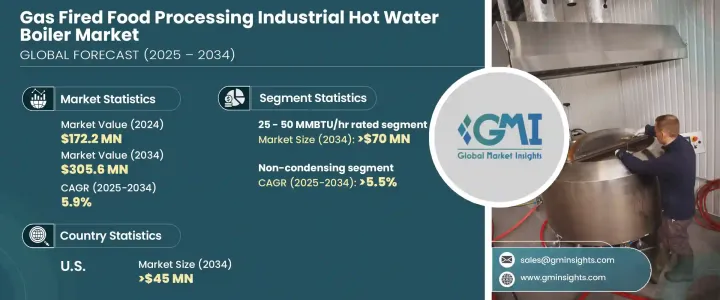
|
시장보고서
상품코드
1684563
가스 연소 식품 가공 산업용 온수 보일러 시장 : 기회, 성장 촉진요인, 산업 동향 분석(2025-2034년)Gas Fired Food Processing Industrial Hot Water Boiler Market Opportunity, Growth Drivers, Industry Trend Analysis, and Forecast 2025 - 2034 |
||||||
세계의 가스 연소 식품 가공 산업용 온수 보일러 시장은 2024년 1억 7,220만 달러로 평가되었으며, 2034년까지 연평균 성장률(CAGR) 5.9%로 성장할 것으로 예상됩니다.
급속한 도시화와 전 세계적인 식량 수요 증가에 따른 산업 환경의 확장은 시장 발전에 중요한 역할을 하고 있습니다. 전 세계 정부가 탄소 배출을 억제하기 위해 환경 규제를 강화하면서 에너지 효율이 높고 지속 가능한 난방 솔루션을 채택해야 한다는 압박이 커지고 있습니다. 또한 디지털 모니터링 시스템, 개선된 소재, 향상된 연소 제어 메커니즘 등 보일러 기술의 지속적인 발전으로 식품 가공 부문 전반에서 보일러 도입이 증가할 것으로 예상됩니다. 기업들은 운영 요구 사항을 충족하기 위해 안정적이고 비용 효율적인 솔루션을 점점 더 많이 찾고 있으며, 가스 연소 산업용 온수 보일러는 성능과 효율성의 완벽한 균형을 제공합니다.

천연가스 연소 산업용 온수 보일러 시장, 특히 시간당 25-50MMBTU급 보일러 시장은 2034년까지 7,000만 달러에 달할 것으로 예상됩니다. 이러한 중형 보일러에 대한 수요를 촉진하는 중요한 요인은 보다 지속 가능한 난방 옵션으로의 전환입니다. 산업 운영자는 운영 비용을 낮출 뿐만 아니라 배출량에 대한 엄격한 정부 규제에 부합하는 솔루션을 채택하고자 합니다. 에너지 가격 상승과 천연가스의 가용성 증가로 인해 보일러 시장은 더욱 발전하고 있으며, 다양한 산업 분야에 매력적인 투자처가 되고 있습니다. 또한 재생 에너지원에 대한 강조가 높아지면서 시장 확장을 위한 새로운 길이 열리고 있어 천연가스 연소 솔루션에 대한 관심이 더욱 높아지고 있습니다.
| 시장 범위 | |
|---|---|
| 시작 연도 | 2024년 |
| 예측 연도 | 2025-2034년 |
| 시작금액 | 1억 7,220만 달러 |
| 예측 금액 | 3억 560만 달러 |
| CAGR | 5.9% |
반면에 비응축식 가스 연소 산업용 온수 보일러 시장은 2034년까지 매년 5.5%의 성장률을 보일 것으로 예상됩니다. 이러한 시스템은 내구성, 낮은 유지보수 요구 사항 및 단순성으로 인해 선호되며 보일러 성능에 대한 요구 사항이 적은 산업에 이상적인 선택입니다. 특히 식품 산업은 바로 먹을 수 있고 위생적으로 포장된 식품에 대한 소비자의 선호로 인해 이러한 수요에 크게 기여하고 있습니다. 고온 보일러는 부식 위험이 최소화되는 산업 환경에서 특히 인기가 높으며, 식품 가공 시설에서 장기간 사용할 수 있는 비응축식 보일러의 매력도 더해지고 있습니다.
밈국의 가스 연소 식품 가공 산업용 온수 보일러 시장은 2034년까지 4,500만 달러에 달할 것으로 예상됩니다. 변동하는 온수 수요에 쉽게 적응할 수 있는 이러한 시스템의 확장성과 신뢰성이 이 부문의 성장을 주도하고 있습니다. 실시간 진단과 효율적인 운영을 가능하게 하는 최신 제어 시스템의 통합도 시장 전망을 밝게 하고 있습니다. 또한 에너지 효율 기술에 대한 세금 공제, 보조금 및 리베이트와 같은 정부 인센티브는 미국 시장의 성장을 더욱 촉진하여 가스 연소 산업용 보일러를 보다 지속 가능한 산업 관행으로의 전환의 핵심 요소로 만들 것으로 예상됩니다.
목차
제1장 조사 방법과 조사 범위
- 시장 범위와 정의
- 시장 추계 및 예측 파라미터
- 예측 계산
- 데이터 소스
- 1차
- 2차
- 유료
- 공적
제2장 주요 요약
제3장 업계 인사이트
- 업계 생태계 분석
- 규제 상황
- 업계에 미치는 영향요인
- 성장 촉진요인
- 업계의 잠재적 리스크 및 과제
- 성장 가능성 분석
- Porter's Five Forces 분석
- PESTEL 분석
제4장 경쟁 구도
- 소개
- 전략적 전망
- 혁신과 지속가능성의 전망
제5장 시장 규모와 예측 : 용량별(2021-2034년)
- 주요 동향
- 10MMBTU/hr 이하
- 10-25MMBTU/hr
- 25-50MMBTU/hr
- 50-75MMBTU/hr
- 75MMBTU/hr 이상
제6장 시장 규모와 예측 : 기술별(2021-2034년)
- 주요 동향
- 응축
- 비응축
제7장 시장 규모와 예측 : 지역별(2021-2034년)
- 주요 동향
- 북미
- 미국
- 캐나다
- 멕시코
- 유럽
- 영국
- 프랑스
- 독일
- 이탈리아
- 러시아
- 스페인
- 아시아태평양
- 중국
- 호주
- 인도
- 일본
- 한국
- 중동 및 아프리카
- 사우디아라비아
- 아랍에미리트(UAE)
- 터키
- 남아프리카
- 이집트
- 라틴아메리카
- 브라질
- 아르헨티나
제8장 기업 프로파일
- ALFA LAVAL
- Babcock Wanson
- Bosch Industriekessel
- California Boiler
- Cleaver-Brooks
- EPCB Boiler
- Forbes Marshall
- Fulton
- Hoval
- Hurst Boiler &Welding
- Johnston Boiler
- Miura America
- Thermax
- Thermodyne Boilers
- Viessmann
The Global Gas Fired Food Processing Industrial Hot Water Boiler Market reached USD 172.2 million in 2024 and is expected to continue at a CAGR of 5.9% through 2034. The expanding industrial landscape, driven by rapid urbanization and increasing global demand for food, is playing a significant role in market development. As governments worldwide tighten environmental regulations to curb carbon emissions, the pressure to adopt more energy-efficient and sustainable heating solutions is growing. Moreover, continuous advancements in boiler technologies, including digital monitoring systems, improved materials, and enhanced combustion control mechanisms, are expected to drive adoption across the food processing sector. Businesses are increasingly seeking reliable, cost-effective solutions to meet their operational needs, and gas-fired industrial hot water boilers offer the perfect balance of performance and efficiency.

The market for natural gas-fired industrial hot water boilers, particularly those rated between 25 and 50 MMBTU/hr, is projected to reach USD 70 million by 2034. A significant factor fueling the demand for these mid-sized boilers is the shift towards more sustainable heating options. Industrial operators are keen to adopt solutions that not only lower operational costs but also align with stricter government regulations on emissions. The combination of rising energy prices and the growing availability of natural gas is also propelling the market forward, making these boilers an attractive investment for a wide range of industries. Additionally, the rising emphasis on renewable energy sources is opening up new avenues for market expansion, further driving interest in natural gas-fired solutions.
| Market Scope | |
|---|---|
| Start Year | 2024 |
| Forecast Year | 2025-2034 |
| Start Value | $172.2 Million |
| Forecast Value | $305.6 Million |
| CAGR | 5.9% |
Meanwhile, the non-condensing gas-fired industrial hot water boilers market is expected to grow at a rate of 5.5% annually through 2034. These systems are favored for their durability, low maintenance requirements, and simplicity, making them an ideal choice for industries with fewer demands on boiler performance. The food industry, in particular, is a significant contributor to this demand, driven by consumer preferences for ready-to-eat and hygienically packaged food products. High-temperature boilers are especially popular in industrial settings where the risk of corrosion is minimal, adding to the appeal of non-condensing boilers for long-term use in food processing facilities.
The U.S. market for gas-fired food processing industrial hot water boilers is projected to reach USD 45 million by 2034. The scalability and reliability of these systems, which allow businesses to easily adjust to fluctuating hot water demands, are driving growth in this segment. The integration of modern control systems that enable real-time diagnostics and efficient operation is also boosting market prospects. In addition, government incentives such as tax credits, grants, and rebates for energy-efficient technologies are expected to further stimulate growth in the U.S. market, making gas-fired industrial boilers a key component of the country's shift toward more sustainable industrial practices.
Table of Contents
Chapter 1 Methodology & Scope
- 1.1 Market scope & definitions
- 1.2 Market estimates & forecast parameters
- 1.3 Forecast calculation
- 1.4 Data sources
- 1.4.1 Primary
- 1.4.2 Secondary
- 1.4.2.1 Paid
- 1.4.2.2 Public
Chapter 2 Executive Summary
- 2.1 Industry synopsis, 2021 - 2034
Chapter 3 Industry Insights
- 3.1 Industry ecosystem analysis
- 3.2 Regulatory landscape
- 3.3 Industry impact forces
- 3.3.1 Growth drivers
- 3.3.2 Industry pitfalls & challenges
- 3.4 Growth potential analysis
- 3.5 Porter's analysis
- 3.5.1 Bargaining power of suppliers
- 3.5.2 Bargaining power of buyers
- 3.5.3 Threat of new entrants
- 3.5.4 Threat of substitutes
- 3.6 PESTEL analysis
Chapter 4 Competitive Landscape, 2024
- 4.1 Introduction
- 4.2 Strategic outlook
- 4.3 Innovation & sustainability landscape
Chapter 5 Market Size and Forecast, By Capacity, 2021 – 2034 (Units, MMBTU/hr & USD Million)
- 5.1 Key trends
- 5.2 < 10 MMBTU/hr
- 5.3 10 - 25 MMBTU/hr
- 5.4 25 - 50 MMBTU/hr
- 5.5 50 - 75 MMBTU/hr
- 5.6 > 75 MMBTU/hr
Chapter 6 Market Size and Forecast, By Technology, 2021 – 2034 (Units, MMBTU/hr & USD Million)
- 6.1 Key trends
- 6.2 Condensing
- 6.3 Non-condensing
Chapter 7 Market Size and Forecast, By Region, 2021 – 2034 (Units, MMBTU/hr & USD Million)
- 7.1 Key trends
- 7.2 North America
- 7.2.1 U.S.
- 7.2.2 Canada
- 7.2.3 Mexico
- 7.3 Europe
- 7.3.1 UK
- 7.3.2 France
- 7.3.3 Germany
- 7.3.4 Italy
- 7.3.5 Russia
- 7.3.6 Spain
- 7.4 Asia Pacific
- 7.4.1 China
- 7.4.2 Australia
- 7.4.3 India
- 7.4.4 Japan
- 7.4.5 South Korea
- 7.5 Middle East & Africa
- 7.5.1 Saudi Arabia
- 7.5.2 UAE
- 7.5.3 Turkey
- 7.5.4 South Africa
- 7.5.5 Egypt
- 7.6 Latin America
- 7.6.1 Brazil
- 7.6.2 Argentina
Chapter 8 Company Profiles
- 8.1 ALFA LAVAL
- 8.2 Babcock Wanson
- 8.3 Bosch Industriekessel
- 8.4 California Boiler
- 8.5 Cleaver-Brooks
- 8.6 EPCB Boiler
- 8.7 Forbes Marshall
- 8.8 Fulton
- 8.9 Hoval
- 8.10 Hurst Boiler & Welding
- 8.11 Johnston Boiler
- 8.12 Miura America
- 8.13 Thermax
- 8.14 Thermodyne Boilers
- 8.15 Viessmann




















